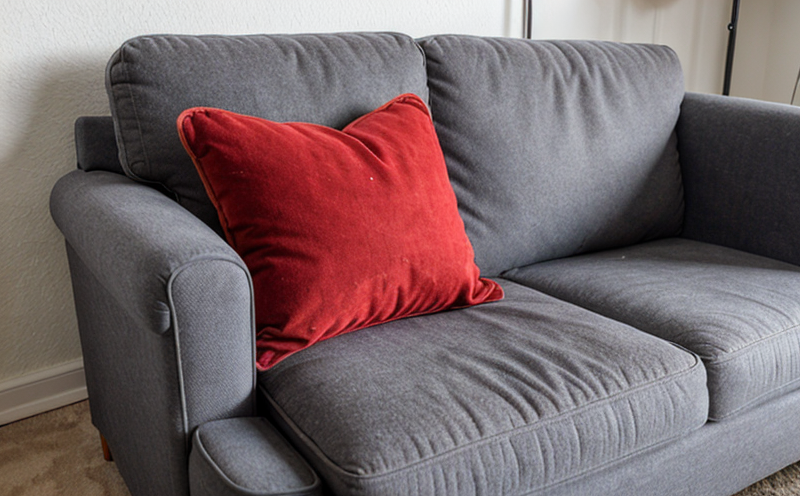UNE EN 1021-1 Fire Testing of Upholstered Furniture Cushion Covers
The UNE EN 1021-1 standard is a crucial requirement for manufacturers and suppliers of upholstered furniture, specifically focusing on the fire resistance properties of cushion covers. This test evaluates how well the materials used in these cushions can withstand exposure to fire without significant degradation or failure. Upholstered furniture is one of the most common furnishings found in residential, commercial, and public spaces, making it essential that its components meet stringent safety standards.
The standard's primary goal is to ensure that cushion covers do not contribute significantly to a fire hazard by burning too quickly or producing excessive amounts of smoke. The test involves exposing the cushion cover specimens to specific thermal environments designed to simulate real-world fire conditions. This allows manufacturers and suppliers to demonstrate compliance with regulatory requirements, thereby enhancing product safety and consumer confidence.
The testing process is highly regulated and requires precise control over various factors such as temperature, duration, and material properties of the specimens. It’s important for companies involved in this sector to understand these nuances since non-compliance can lead to costly recalls, reputational damage, and even legal issues. By adhering to UNE EN 1021-1 standards, businesses not only comply with international regulations but also enhance their market competitiveness by demonstrating superior product quality.
Manufacturers who follow this standard closely have a competitive advantage in the global market due to increased trust among consumers regarding fire safety. Moreover, meeting these stringent requirements can open doors to new markets and opportunities for business growth. Understanding the intricacies of UNE EN 1021-1 is therefore vital not only for compliance but also for long-term success in this competitive industry.
The standard covers a wide range of cushion cover materials including synthetic fabrics, natural fibers, blends, and more. It ensures that all these materials perform equally well under fire conditions, providing consistent protection across different types of products. Compliance with UNE EN 1021-1 also implies adherence to broader international standards such as ISO and ASTM, which further reinforces its importance in the industry.
In summary, UNE EN 1021-1 fire testing is not just a compliance exercise but an integral part of ensuring product safety. By investing time and resources into understanding and implementing this standard, manufacturers can build stronger relationships with clients, improve brand reputation, and ultimately achieve greater success in their respective markets.
Applied Standards
The UNE EN 1021-1 fire testing is governed by several internationally recognized standards. These include:
- UNE EN 1021-1: Fire performance of upholstered furniture and its components - Part 1: General requirements
- ISO 19985: Upholstered furniture - Determination of fire resistance of cushion covers
- ASTM D7346: Standard test method for determining the flame spread characteristics of fabric materials used in upholstered furniture cushions
- EN ISO 17172: Upholstered furniture and components - Determination of smoke production rate of fabrics
The harmonization of these standards ensures that fire testing procedures are consistent across different jurisdictions, promoting uniformity and reliability in the assessment of fire resistance properties.
Scope and Methodology
| Parameter | Description |
|---|---|
| Test Specimens | Upholstered cushion covers made from synthetic, natural, or blended fabrics. |
| Temperature and Duration | Specified thermal environments to simulate real-world fire conditions. |
| Sample Preparation | Cushion covers are cut into standard dimensions as per the test requirements. |
| Instrumentation | Thermal testing apparatus capable of maintaining precise temperature and duration settings. |
| Data Collection | Measurement of flame spread, smoke production rate, and other relevant parameters. |
| Acceptance Criteria | The cushion cover must meet the specified criteria to pass the test successfully. |
The testing process involves several key steps. Initially, the cushion covers are prepared according to predefined specifications. Then they are exposed to defined thermal environments designed to simulate various fire scenarios. During this exposure, detailed measurements and observations are recorded regarding flame spread behavior, smoke production rates, and other relevant parameters.
Once the test is complete, a comprehensive report summarizing all findings is generated. This report includes not only raw data but also interpretations based on international standards. It serves as definitive proof of compliance with UNE EN 1021-1 requirements. Understanding these methods allows manufacturers to make informed decisions about material selection and process improvements.
Environmental and Sustainability Contributions
Compliance with the UNE EN 1021-1 standard has far-reaching benefits beyond mere regulatory adherence. It contributes significantly towards environmental sustainability by promoting the use of safer materials that are less likely to fuel fires or produce hazardous smoke. This reduces potential risks associated with accidental fires, thereby protecting both human health and property.
By ensuring high levels of fire resistance, this standard helps minimize waste generation during production processes since non-compliant products may need rework or disposal if they fail the test. Such practices contribute positively towards resource efficiency within manufacturing facilities.
In addition to direct environmental impacts, adhering to UNE EN 1021-1 promotes better indoor air quality by reducing emissions of harmful pollutants during fires. This is particularly beneficial in densely populated areas where fire incidents could have severe consequences.
Overall, compliance with this standard aligns well with broader goals related to sustainable development and responsible consumption practices advocated by various global initiatives. It encourages innovation within the industry towards developing more resilient and environmentally friendly products.





